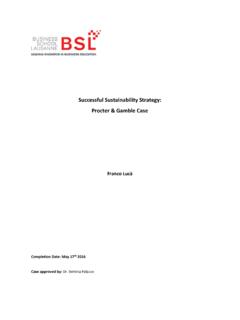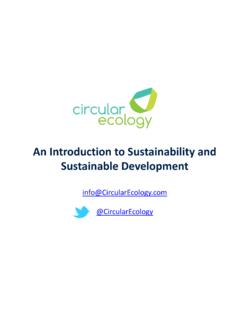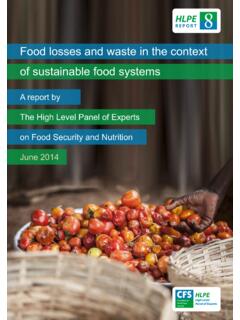Transcription of Clarifying the Meaning of © 2015 SAGE Publications ...
1 Organization & Environment 1 19 2015 SAGE PublicationsReprints and DOI: the Meaning of Sustainable Business: Introducing a Typology From Business-as-Usual to True Business SustainabilityThomas Dyllick1 and Katrin Muff2 AbstractWhile sustainability management is becoming more widespread among major companies, the impact of their activities does not reflect in studies monitoring the state of the planet. What results from this is a big disconnect. With this article, we address two main questions: How can business make an effective contribution to addressing the sustainability challenges we are facing?
2 And When is business truly sustainable? In a time when more and more corporations claim to manage sustainably, we need to distinguish between those companies that contribute effectively to sustainability and those that do not. We provide an answer by Clarifying the Meaning of business sustainability . We review established approaches and develop a typology of business sustainability with a focus on effective contributions for sustainable development. This typology ranges from Business sustainability (Refined Shareholder Value Management) to Business sustainability (Managing for the Triple Bottom Line) and to Business sustainability (True sustainability ).
3 Keywordsbusiness sustainability , corporate sustainability , triple bottom line, planetary challenges, corporate social responsibility, responsible leadership, purpose of the firm, sustainable development, sustainable businessIntroductionWhile sustainability management is becoming more widespread among major companies, the impact of their activities is not reflected in studies that monitor the state of the planet. The con-sequence is a big disconnect between micro-level progress and macro-level deterioration. We respond to this disconnect by critically looking at how business sustainability (BST) has been discussed in the academic literature and in practice and by reframing the this article, we address two main questions: How can business make an effective con-tribution to resolving the sustainability challenges we are collectively facing?
4 And When is business truly sustainable? In a time when more and more corporations claim to manage 1 University of St. Gallen, St. Gallen, Switzerland2 Business School Lausanne, Lausanne, SwitzerlandCorresponding Author:Katrin Muff, Business School Lausanne, Lausanne, : & EnvironmentDyllick and Muffresearch-article2015 at Universitaet St Gallen on March 29, from 2 Organization & Environment sustainably, we need to distinguish between those companies that do and those that do not make effective contributions to sustainable development. In order to do so, we will clarify the Meaning of BST by reviewing established approaches and by developing a typology that focusses on effective contributions for sustainable development (SD).
5 This should help assess companies on their journey toward integrating BST into their strategies and business models. And it provides a framework for scholars and professionals to engage in the transformation of business, moving from business-as-usual to true business sustainability . We will not address the required changes in the underlying economic model or in the model of consumer behavior, although effective changes are clearly start out by looking in more detail at this big disconnect between sustainable business on an organizational level and SD on a global level, and thus set the stage for our discussion of existing models of BST.
6 We then develop a new typology for BST that will range from Business sustainability (Refined Shareholder Value Management) to Business sustainability (Managing for the Triple Bottom Line) and to Business sustainability (True sustainability ). In the last section, we present our conclusions and Business and Sustainable Development: The Big DisconnectThe role of business in making our world a more sustainable place is at the center of the study of sustainability management. If we follow the studies monitoring the acceptance and integration of sustainability by big companies, there is a strong consensus emerging that sustainability is having and will continue to have a significant material impact on company strategies and operations.
7 More and more business executives agree that sustainability -related strategies are necessary to be competitive today and even more so in the future. More and more executives report that their organizations commitment to sustainability has increased in the past and will develop further in the future. They report that benefits of addressing sustainability accrue not only to the environ-ment and to society but also to the companies themselves, through tangible benefits in the form of reduced costs and risks of doing business, as well as through intangible benefits in the form of increased brand reputation, increased attractiveness to talent, and increased competiveness (Haanaes et al.)
8 , 2011; Haanaes et al., 2012; Kron, Kruschwitz, Haanaes, Reeves, & Goh, 2013; Global Compact & Accenture, 2010 & 2013). But somehow this good news is not reflected in studies monitoring the state of our planet. Here we learn that poverty has not been eradicated, inequity is growing, hunger and malnutrition still kills a child every 6 seconds, billion people do not have access to clean drinking water and sanitation, billion people do not have access to electricity, and a 4-degree warming scenario is now being accepted by international organiza-tions like the World Bank and the International Energy Agency, while the international climate negotiations have failed to produce any consensus on effective global strategies to keep global warming at least below 2 degrees (Bakker, 2012.
9 Gilding, 2011; Environment Programme, 2012; WWF, 2012).What results from this discrepancy between micro-level progress and macro-level deteriora-tion is a big disconnect between company activities and the global state of the environment and society. Although there are different reasons to explain this disconnect after all corporations are not the only relevant actors in the global sustainability arena the current situation should be considered as a wake-up call for business people and management scholars alike that their good intentions and actions have not been leading to significant sustainability improvements on a global level.
10 In response to this disconnect, we critically look at how the concept of BST has been used in the academic literature and in the world of practice, and we then reframe this concept. In doing so, we do not assume this alone will solve the problem, but we believe that by Clarifying at Universitaet St Gallen on March 29, from Dyllick and Muff 3the Meaning of BST, a better understanding of the impact business can have on global sustain-ability will set the discussion at least on the right looking at the BST debate in the academic literature, we find three conceptual challenges for addressing the disconnect.






